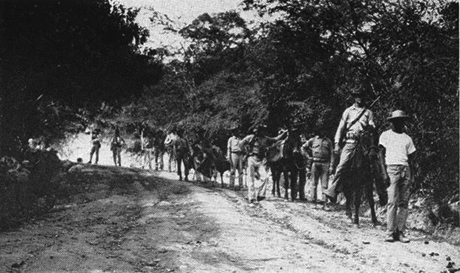
The United States occupation of Haiti began on July 28, 1915, when 330 U.S. Marines landed at Port-au-Prince, Haiti, on the authority of President Woodrow Wilson to safeguard the interests of U.S. corporations.
Between 1911-15, the presidency of Haiti changed six times. Various peasant armies carried out this series of coups. The U.S. was particularly apprehensive about the roles (real and imagined) played by Germany, a rising imperial power which had intervened in the Western hemisphere, including Haiti, to exert its influence as a rival to American domination.
By 1915 Europe was already at war, and the U.S. feared that Germany might use Haiti and the Dominican Republic, sharing the island of Hispaniola, for espionage and expanding military interests in Latin America.
The small German community in Haiti of approximately 200 in 1910 wielded a disproportionately high amount of economic power. German nationals controlled about 80 percent of the country’s international commerce, owned a railroad and operated utilities in Cap Haitien and Port-au-Prince, the main wharf and a tramway in the capital.
Some Germans married into the nation’s most prominent mulatto families, thus bypassing the constitutional prohibition against foreign land ownership and posing an economic threat to American financial, political and military interests. To limit German influence, the State Department backed a consortium of American investors, assembled by the National City Bank of New York, in acquiring control of the Banque Nationale d’Haiti, the nation’s only commercial bank and the government treasury.
In July 1915, the current dictator Jean Vilbrun Guillaume Sam, massacred 167 political prisoners, all from elite families, particularly from the better educated and wealthier mulatto population with German affiliations. In the aftermath, Sam in turn was lynched by a mob in Port-au-Prince, allegedly organized by American business interests in the country, such as the Haitian American Sugar Company. With the invasion by the Marines, the American government preserved their economic dominance over Haiti.
The story of Haiti is a case study in the injustice of the international finance and monetary system. The Haitian government had been receiving large loans from both American and French banks over the past few decades and was growing increasingly incapable of fulfilling their debt repayment. Within six weeks of the occupation, U.S. agents controlled Haitian customs houses, banks and the national treasury. In September 1915, the U.S. Senate ratified the Haitian-American Convention, a “treaty” granting American oversight of Haiti for a 10-year period. From that point on, 40 percent of the national income was used to pay off the banks, depriving the economy of resources for development.
Opposition to the occupation began immediately. The rebels, called “cacos” by the Marines and in part subsidized by the German government and the local German-Haitian elite, vehemently tried to resist American control. The Americans set about to disband the rebel armies. The best-known account of this campaign came from Marine Major Smedley Butler, awarded a Medal of Honor for his exploits, who went on to serve as commanding officer of the Haitian Gendarmerie. Butler later expressed his disapproval of the U.S. intervention, and of imperialism in general, in his book “War Is a Racket.”
Racial attitudes towards the Haitian people by the American occupation forces were blatant. Segregationist housing and mass killings of Haitians by U.S. military aroused protest from the NAACP at home. Many Haitians continued to resent their loss of sovereignty. World War I ended the German influence in Haiti; now opponents of the occupation reached out to allies within the U.S. itself.
The NAACP sent the black American writer James Weldon Johnson to Haiti to discover the real situation in the country. Johnson’s series of scathing articles in the Nation magazine helped rally domestic American opinion against the occupation.
Once the Depression hit, whatever economic development Haiti had achieved under the Americans largely dissipated. Haitian laborers traveled to work in the sugar industries of Cuba and the Dominican Republic.
For 19 years, U.S. “advisers” governed the country, enforced by the U.S. Marine Corps. The formal occupation ended in August 1934, under President Franklin D. Roosevelt, proponent of the Good Neighbor policy, although the U.S. retained influence on Haiti’s external finances until 1947.
Adapted from Wikipedia and other sources.
Photo: “Occupation of Haiti” by A. R. Harrison, United States Marine Corps – Marine Corps Legacy Museum, Harrison, AR. Licensed under Public Domain via Wikimedia Commons.

MOST POPULAR TODAY

High Court essentially bans demonstrations, freedom of assembly in Deep South

UN warns that Israel is still blocking humanitarian aid to Gaza

Resource wars rage in eastern Congo, but U.S. capitalism only sees investment opportunity

U.S. imperialism’s ‘ironclad’ support for Israel increases fascist danger at home







Comments